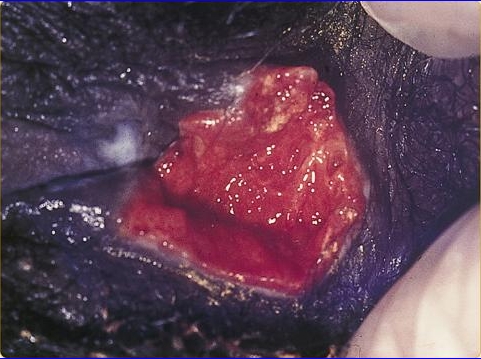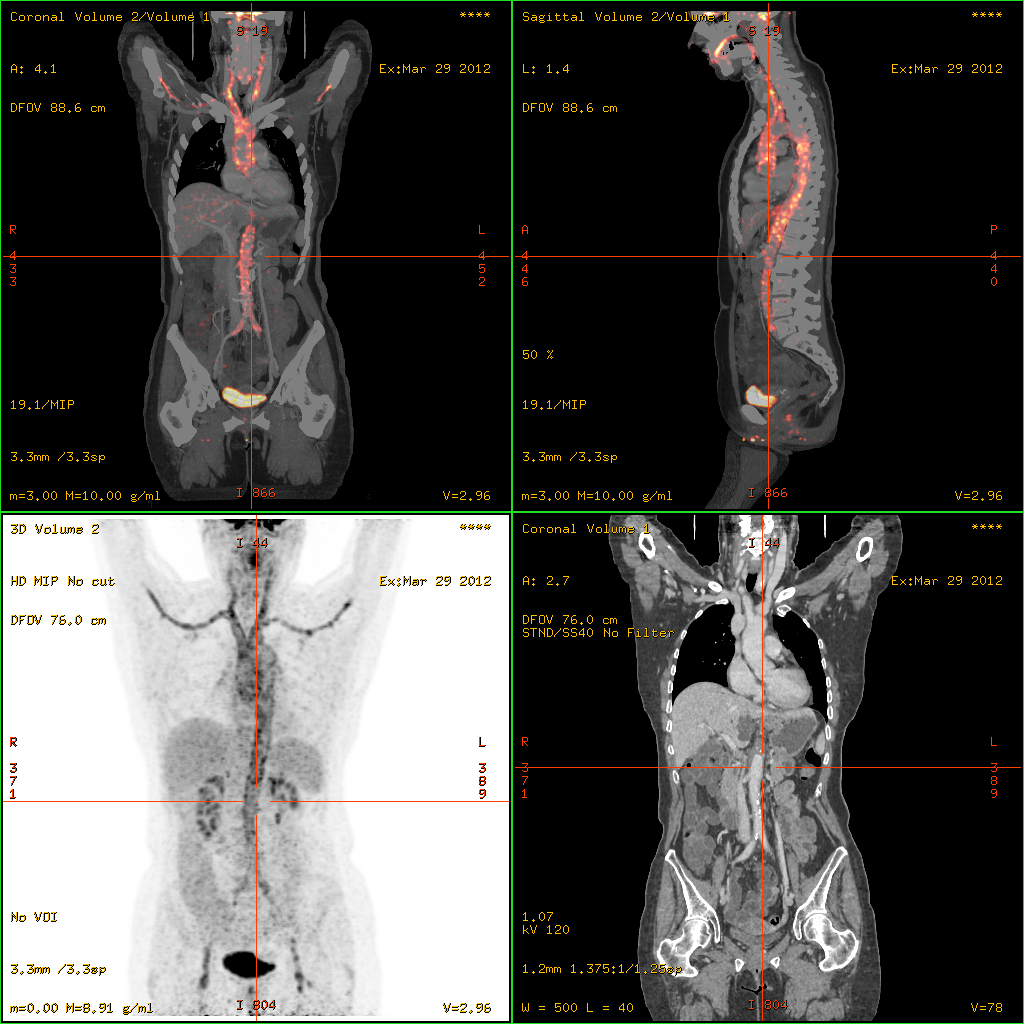|
Granuloma Annulare
Granuloma annulare (GA) is a rare, sometimes chronic skin condition which presents as reddish bumps on the skin arranged in a circle or ring. It can initially occur at any age, though two-thirds of patients are under 30 years old, and it is seen most often in children and young adults. Females are two times as likely to have it as males. Signs and symptoms Aside from the visible rash, granuloma annulare is usually asymptomatic. Sometimes the rash may burn or itch. People with GA usually notice a ring of small, firm bumps (papules) more commonly over the backs of the forearms, hands or feet, often centered on joints or knuckles. GA, however, can be anywhere on the body and has also been seen on necks, backs, ankles and wrists. Bumps are caused by the clustering of T cells below the skin. These papules start as very small, pimple looking bumps, which spread over time from that size to dime, quarter, half-dollar size and beyond. Occasionally, multiple rings may join into one. Rarel ... [...More Info...] [...Related Items...] OR: [Wikipedia] [Google] [Baidu] |
Granuloma Inguinale
Granuloma inguinale is a bacterial disease caused by '' Klebsiella granulomatis'' (formerly known as ''Calymmatobacterium granulomatis'') characterized by genital ulcers. It is endemic in many less-developed regions. It is also known as donovanosis, granuloma genitoinguinale, granuloma inguinale tropicum, granuloma venereum, granuloma venereum genitoinguinale, lupoid form of groin ulceration, serpiginous ulceration of the groin, ulcerating granuloma of the pudendum, and ulcerating sclerosing granuloma. Oral manifestations are also notably seen. The lesions of oral cavity are usually secondary to active genital lesions. The disease often goes untreated because of the scarcity of medical treatment in the countries in which it is found. In addition, the painless genital ulcers can be mistaken for syphilis. The ulcers ultimately progress to destruction of internal and external tissue, with extensive leakage of mucus and blood from the highly vascular lesions. The destructive nature ... [...More Info...] [...Related Items...] OR: [Wikipedia] [Google] [Baidu] |
Skin Trauma
Skin trauma is serious and altering physical injury experienced by the skin or multiple layers of epithelial tissue Epithelium or epithelial tissue is a thin, continuous, protective layer of cells with little extracellular matrix. An example is the epidermis, the outermost layer of the skin. Epithelial ( mesothelial) tissues line the outer surfaces of man ...s. This can be in the form of cuts, burns, sickness or other injury. References Dermatologic terminology Cutaneous lesion {{dermatology-stub ... [...More Info...] [...Related Items...] OR: [Wikipedia] [Google] [Baidu] |
Pathogenesis
In pathology, pathogenesis is the process by which a disease or disorder develops. It can include factors which contribute not only to the onset of the disease or disorder, but also to its progression and maintenance. The word comes . Description Types of pathogenesis include microbial infection, inflammation, malignancy and tissue breakdown. For example, bacterial pathogenesis is the process by which bacteria cause infectious illness. Most diseases are caused by multiple processes. For example, certain cancers arise from dysfunction of the immune system (skin tumors and lymphoma after a renal transplant, which requires immunosuppression), '' Streptococcus pneumoniae'' is spread through contact with respiratory secretions, such as saliva, mucus, or cough droplets from an infected person and colonizes the upper respiratory tract and begins to multiply. The pathogenic mechanisms of a disease (or condition) are set in motion by the underlying causes, which if controlled woul ... [...More Info...] [...Related Items...] OR: [Wikipedia] [Google] [Baidu] |
Vasculitis
Vasculitis is a group of disorders that destroy blood vessels by inflammation. Both artery, arteries and veins are affected. Lymphangitis (inflammation of lymphatic vessels) is sometimes considered a type of vasculitis. Vasculitis is primarily caused by white blood cell, leukocyte migration and resultant damage. Although both occur in vasculitis, inflammation of veins (phlebitis) or arteries (arteritis) on their own are separate entities. Signs and symptoms The clinical presentation of the various vasculitides on the skin and internal organs is mostly determined by the diameter or size of the vessels mainly affected. Non-specific symptoms are common and include fever, headache, fatigue, myalgia, weight loss, and arthralgia. All forms of vasculitis, even large vessel vasculitides, may cause skin manifestations. The most common skin manifestations include purpura, Nodule (dermatology), nodules, livedo reticularis, Ulcer (dermatology), skin ulcers, and purpuric Hives, urticaria. ... [...More Info...] [...Related Items...] OR: [Wikipedia] [Google] [Baidu] |
Type III Hypersensitivity
Type III hypersensitivity, in the Gell and Coombs classification of allergic reactions, occurs when there is accumulation of immune complexes (antigen-antibody complexes) that have not been adequately cleared by innate immune cells, giving rise to an inflammatory response and attraction of leukocytes. There are three steps that lead to this response. The first step is immune complex formation, which involves the binding of antigens to antibodies to form mobile immune complexes. The second step is immune complex deposition, during which the complexes leave the plasma and are deposited into tissues. Finally, the third step is the inflammatory reaction, during which the classical pathway is activated and macrophages and neutrophils are recruited to the affected tissues. Such reactions may progress to immune complex diseases. Types Some clinical examples: Other examples are: * Subacute bacterial endocarditis * Symptoms of malaria Pathogenesis Gel and Coombs defined type III ... [...More Info...] [...Related Items...] OR: [Wikipedia] [Google] [Baidu] |
Immune-mediated
An immune disorder is a dysfunction of the immune system. These disorders can be characterized in several different ways: * By the component(s) of the immune system affected * By whether the immune system is overactive or underactive * By whether the condition is congenital or acquired According to the International Union of Immunological Societies, more than 150 primary immunodeficiency diseases (PIDs) have been characterized. However, the number of acquired immunodeficiencies exceeds the number of PIDs. It has been suggested that most people have at least one primary immunodeficiency. Due to redundancies in the immune system, though, many of these are never detected. Autoimmune diseases An autoimmune disease is a condition arising from an abnormal immune response to a normal body part. There are at least 80 types of autoimmune diseases. Nearly any body part can be involved. Common symptoms include low-grade fever and feeling tired. Often symptoms come and go. List of some ... [...More Info...] [...Related Items...] OR: [Wikipedia] [Google] [Baidu] |
Fibrinogen
Fibrinogen (coagulation factor I) is a glycoprotein protein complex, complex, produced in the liver, that circulates in the blood of all vertebrates. During tissue and vascular injury, it is converted Enzyme, enzymatically by thrombin to fibrin and then to a fibrin-based Thrombus, blood clot. Fibrin clots function primarily to occlude blood vessels to stop bleeding. Fibrin also binds and reduces the activity of thrombin. This activity, sometimes referred to as antithrombin I, limits clotting. Fibrin also mediates blood platelet and endothelial cell spreading, tissue fibroblast proliferation, Capillary action, capillary tube formation, and angiogenesis and thereby promotes revascularization and wound healing. Reduced and/or dysfunctional fibrinogens occur in various congenital and acquired human List of fibrinogen disorders, fibrinogen-related disorders. These disorders represent a group of rare conditions in which individuals may present with severe episodes of pathological bleed ... [...More Info...] [...Related Items...] OR: [Wikipedia] [Google] [Baidu] |
Complement System
The complement system, also known as complement cascade, is a part of the humoral, innate immune system and enhances (complements) the ability of antibodies and phagocytic cells to clear microbes and damaged cells from an organism, promote inflammation, and attack the pathogen's cell membrane. Despite being part of the innate immune system, the complement system can be recruited and brought into action by antibodies generated by the adaptive immune system. The complement system consists of a number of small, inactive, liver synthesized protein precursors circulating in the blood. When stimulated by one of several triggers, proteases in the system cleave specific proteins to release cytokines and initiate an amplifying cascade of further cleavages. The end result of this ''complement activation'' or ''complement fixation'' cascade is stimulation of phagocytes to clear foreign and damaged material, inflammation to attract additional phagocytes, and activation of the cell-killi ... [...More Info...] [...Related Items...] OR: [Wikipedia] [Google] [Baidu] |
Immunoglobulin M
Immunoglobulin M (IgM) is the largest of several isotypes of antibodies (also known as immunoglobulin) that are produced by vertebrates. IgM is the first antibody to appear in the response to initial exposure to an antigen; causing it to also be called an acute phase antibody. In humans and other mammals that have been studied, plasmablasts in the spleen are the main source of specific IgM production. History In 1937, an antibody was observed in horses hyper-immunized with pneumococcus polysaccharide that was much larger in size than the typical rabbit γ-globulin, with a molecular weight of 990,000 daltons. In accordance with its larger size, the new antibody was originally referred to as γ-macroglobulin, and subsequently termed IgM—M for “macro”. The V domains of normal immunoglobulin are highly heterogeneous, reflecting their role in protecting against the great variety of infectious microbes, and this heterogeneity impeded detailed structural analysis of IgM. T ... [...More Info...] [...Related Items...] OR: [Wikipedia] [Google] [Baidu] |
Blood Vessel
Blood vessels are the tubular structures of a circulatory system that transport blood throughout many Animal, animals’ bodies. Blood vessels transport blood cells, nutrients, and oxygen to most of the Tissue (biology), tissues of a Body (biology), body. They also take waste and carbon dioxide away from the tissues. Some tissues such as cartilage, epithelium, and the lens (anatomy), lens and cornea of the eye are not supplied with blood vessels and are termed ''avascular''. There are five types of blood vessels: the arteries, which carry the blood away from the heart; the arterioles; the capillaries, where the exchange of water and chemicals between the blood and the tissues occurs; the venules; and the veins, which carry blood from the capillaries back towards the heart. The word ''vascular'', is derived from the Latin ''vas'', meaning ''vessel'', and is mostly used in relation to blood vessels. Etymology * artery – late Middle English; from Latin ''arteria'', from Gree ... [...More Info...] [...Related Items...] OR: [Wikipedia] [Google] [Baidu] |
Viral Infection
A viral disease (or viral infection) occurs when an organism's body is invaded by pathogenic viruses, and infectious virus particles (virions) attach to and enter susceptible cells. Examples include the common cold, gastroenteritis, COVID-19, the flu, and rabies. Structural characteristics Basic structural characteristics, such as genome type, virion shape and replication site, generally share the same features among virus species within the same family. * Double-stranded DNA families: three are non-enveloped (''Adenoviridae'', ''Papillomaviridae'' and ''Polyomaviridae'') and two are enveloped (''Herpesviridae'' and ''Poxviridae''). All of the non-enveloped families have icosahedral capsids. * Partly double-stranded DNA viruses: ''Hepadnaviridae''. These viruses are enveloped. * One family of single-stranded DNA viruses infects humans: ''Parvoviridae''. These viruses are non-enveloped. * Positive single-stranded RNA families: three non-enveloped (''Astroviridae'', ''Calicivirid ... [...More Info...] [...Related Items...] OR: [Wikipedia] [Google] [Baidu] |
Borrelia
''Borrelia'' is a genus of bacteria of the spirochete phylum. Several species cause Lyme disease, also called Lyme borreliosis, a zoonotic, vector-borne disease transmitted by ticks. Other species of ''Borrelia'' cause relapsing fever, and are transmitted by ticks or lice, depending on the species of bacteria. The genus is named after French biologist Amédée Borrel (1867–1936), who first documented the distinction between a species of ''Borrelia anserina'' and the other known type of spirochete at the time, ''Treponema pallidum''. This bacterium must be viewed using dark-field microscopy, which make the cells appear white against a dark background. ''Borrelia'' species are grown in Barbour-Stoenner-Kelly medium. Of 52 known species of ''Borrelia'', 20 are members of the Lyme disease group (with an additional 3 proposed), 29 belong to the relapsing fever group, and two are members of a genetically distinct third group typically found in reptiles. A proposal has been made ... [...More Info...] [...Related Items...] OR: [Wikipedia] [Google] [Baidu] |



